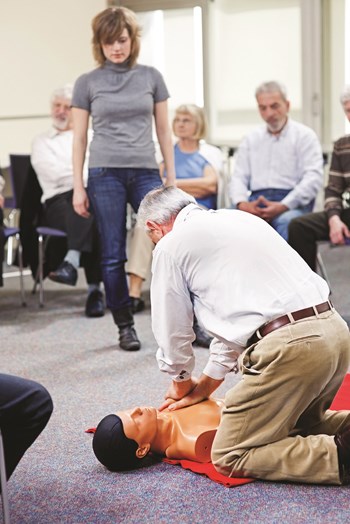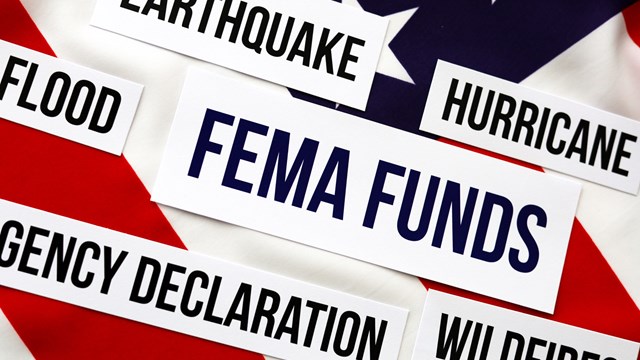
A fire breaks out in an apartment building; A broken water pipe floods several floors; A resident collapses with a heart attack on the tennis court; An intruder roams the premises with criminal intent; and the chilly winds whipping in off Lake Michigan turn your condo’s paved surfaces into a huge ice skating rink and a liability just waiting to happen.
As a result, fire rescue and police personnel are summoned, and they rush to the scene. Until professional first responders arrive however, the situation is in the hands of the community’s on-premises staff and security providers. How does a concierge, doorman, maintenance worker, security guard or property manager learn to deal with such emergencies? In Chicagoland, training is available from many sources.
Common Themes
Building staff members have to handle many different problems, but there are a few situations that are more common than others. According to Jim Stoller, president of The Building Group in Chicago, which manages luxury high-rises, the most common crisis is “Someone trying to enter a property that they don't have appropriate access to. People are always trying to figure a way to get into buildings. I don't care if it's on Lake Shore Drive or if it's in one of the neighborhoods of Chicago—there are always people trying to figure out a way to get in.”
Chicago Property Services specializes in smaller properties—low-rise condos, gated communities and townhomes. President Salvatore J. Sciacca has had the same experience with that sector of the market. “Break-ins, people's units being burglarized,” he says. “That's the most typical security issue that our communities face.”
For Thomas A. Skweres, regional vice president of ACM Community Management in Downers Grove, security is also one of the top three or four problems that association or condo staff encounter. “The most common issues are floods (both natural and plumbing-related), medical emergencies, elevator malfunctions and property security,” he states. “Major disasters, such as tornadoes, or bomb threats and civil disorder, are probably the least likely. But your emergency preparedness plan should cover all potential emergencies, including fires, heavy rainstorms, snowstorms, sewage back-ups, lightning strikes, riots and arson to name a few.”
“On-site staff are the first line of defense,” Skweres continues. “Their job is to remain calm, secure the situation if possible, evacuate the area if necessary, call for assistance, then follow the directions of people in authority.”
So how does a doorman, janitor, maintenance worker, security guard or building superintendent learn just what to do and what not to do? Training is available from many sources. The labor union for building service workers offers courses to its members. Local emergency management agencies train building staff and interested residents through their Community Emergency Response Team (CERT) programs. Some property management companies also have training programs for their client buildings’ staffs. Other sources include non-profit organizations and for-profit companies that sell training classes, printed materials and videos.
Union Courses
Two unions in Chicago—SEIU Local 1 and IUOE Local 399–represent workers from a variety of fields including janitors, security officers, stadium and theater workers, doormen and resident managers, chief engineers, superintendents and maintenance workers.
“Many of our door staff and maintenance staff are union, and there are classes that the union teaches,” says Stoller. Skweres adds, “Many of these courses are required for credit to elevate job status and are required by the collective bargaining agreement.”
In Chicago, classes offered to members of SEIU (Service Employees International Union) Local 1 and financed by the Apartment Building Owners and Managers Association (ABOMA) Training Fund include:
• Certified Pool Operator's Course. Applicants for pool-operator certification through the National Swimming Pool Foundation must attend the two-day course and pass the exam.
• Building Evacuation. A four-hour emergency-management class given by American Safety Training.
• Red Cross CPR Certification. A four-hour course taught by representatives of the Red Cross and leading to certification.
• 10-Week Janitorial Training Program. A thorough course that in addition to maintenance skills includes sections on basic health and safety, CPR and fire safety.
• Door Staff Training. A 16-hour course that includes sessions on building evacuation and on crime prevention and anti-terrorism.
For a schedule of current SEIU classes, visit: www.seiu1.org/chicago-training-center/.
Chicagoland’s Local 399 of the International Union of Operating Engineers (IUOE) also provides training for its unionized workforce at its own training center.
Today, Local 399 has over 10,000 members in Illinois and Indiana, representing both public- and private-sector skilled maintenance workers who operate and maintain building systems in commercial buildings, office buildings, hotels, schools, universities, hospitals, and more.
Local 399 offers a variety of training courses and seminars to educate, train, and challenge its membership. Classes include topics such as boiler operations, indoor air quality, electricity, energy conservation, basic HVAC controls, indoor air quality, facilities sustainability, boiler license prep, engineering and locksmith training. Special training for chief engineers is also provided. Classes are held at a new, state-of-the-art training center in Chicago and several classes are also available online, providing flexibility for busy members.
CERT Training
Local emergency-management agencies also offer free training for community staff and residents through their Community Emergency Response Team (CERT) programs. These programs raise awareness about emergencies and disasters and teach basic response skills for fire safety, search-and-rescue, disaster medical operations, and traffic control. Local teams support their communities by assisting with emergency education and response.
Statewide, CERT training is available in 56 locations in Illinois. For a list of courses, visit www.citizencorps .fema.gov/cc/CertIndex.do?submitByState and click Illinois.
The impetus for CERT training was the major earthquake that struck Mexico City in 1985. Well-intentioned, but untrained, rescuers went into unstable structures and saved 800 people but 100 of the rescuers were killed when aftershocks caused further damage. That prompted the Los Angeles fire department to start training people how to avoid becoming victims themselves. FEMA took the concept nationwide and expanded it to apply to all kinds of emergencies and hazards.
Other Courses
“Various vendors involved in safety and security put on seminars,” says Skweres. Also, the American Heart Association offers courses in first aid, CPR and the use of automated external defibrillators (AED). They are available in a classroom setting in multiple locations or online, for a small fee. For information, visit www.heart.org and search on courses. The American Red Cross also offers low- or no-cost courses in administering emergency oxygen, blood-borne pathogens training, emergency medical response, first aid, and CPR/AED at multiple locations in Illinois. For information, visit www.redcross.org/take-a-class and enter your zip code.
Something else to consider is formal training courses and classes for security guards. Some junior colleges and a number of private schools offer security-guard training, which, in addition to training guards, can give staff members who are not security employees a useful skill set and credential. Generally, to become a licensed security guard in Illinois, you have to complete a 20-hour course.
In-House Training
Management companies themselves also can play a role when it comes to staff safety training. “We do some in-house training for door staff and maintenance, so that they understand their roles,” says Stoller, “and we try to help them and give them the support they need so they can do an excellent job on behalf of their buildings.” “It is the board and management’s responsibility to make sure that a disaster plan is in place and that all staff are familiar with it,” adds Skweres.
“We work with training for our staff so that they know what to do. Every building is unique,” Stoller states, “so we do an emergency plan for each one, trying to understand the issues, what can happen. You have emergency procedures in place so that if you have a problem you know who to contact, you know where shut-off valves are, you know where emergency panels are, you know the lighting panels, you know how to contact vendors. All of that is worked out.”
Having written instructions readily available is important, too. “We have an emergency manual at every property, typically at the front desk, so that the door staff and the maintenance staff have sort of a building bible of what to do and who to contact,” explains Stoller. “We'll list all the emergency contacts, and we'll also do the hierarchy of the management so that they can immediately get in contact with the appropriate management supervisors and we can address the problem.”
All the work of planning and training is necessary because unexpected crises definitely do occur. “We've had major fires, floods, suicides, murders,” says Stoller. “Unfortunately, it's part of life, and management has to be prepared. We had a roof blow off a building.” It is the Windy City, after all.
Changing Times
“The newest thing in Chicago is the Life Safety Ordinance,” says Stoller. It required buildings to install life-safety systems by the end of 2014. “Any building over 80 feet has to have one- and two-way communication systems. So, if there is a real emergency, the fire department has a command module stationed down in the lobby, and they tell people what to do. They can broadcast based on which stairwell people are in or what floor they're on through speaker systems that are throughout the building. Let's say there's a fire on floor eight, and they don't want the people on fifteen to go down the stairs. They can say, 'If you're on floor 15 and above, please stay in your unit.' Or if you're on this floor or that floor, do something else. I think it's an excellent way of approaching emergencies in buildings.”
For such things as weather emergencies forecast for Chicagoland, “We have email and phone contacts,” says Stoller, “and so we will send out either e-blasts or phone calls to the units, or notify people ahead of time through signs around the building. In some of our buildings, we even have monitors in the elevators where we can put up communication.”
Clearly technology has made us better able to cope with emergencies. Attitudes have altered, too. “Things have changed in the last several years” says Skweres. “People are more aware of threats and risk.”
Stoller agrees. “I think our society as a whole has gotten more conscious of security issues, and it may just be because the events in the world are more well known. I don't know that our society has gotten any more violent, if anything, I think it's gotten less so, but I think the perception is that there's more violence out there. I know in Chicago the violence has actually decreased, but the media awareness of it has increased. The number of the shootings is down, but any shooting makes the news,” as seen in recent months. “So, I think that people are very security-conscious, so as a management company, we are very security-conscious.” n
George Leposky is a freelance writer and is a frequent contributor to The Chicagoland Cooperator.






Leave a Comment